Menu
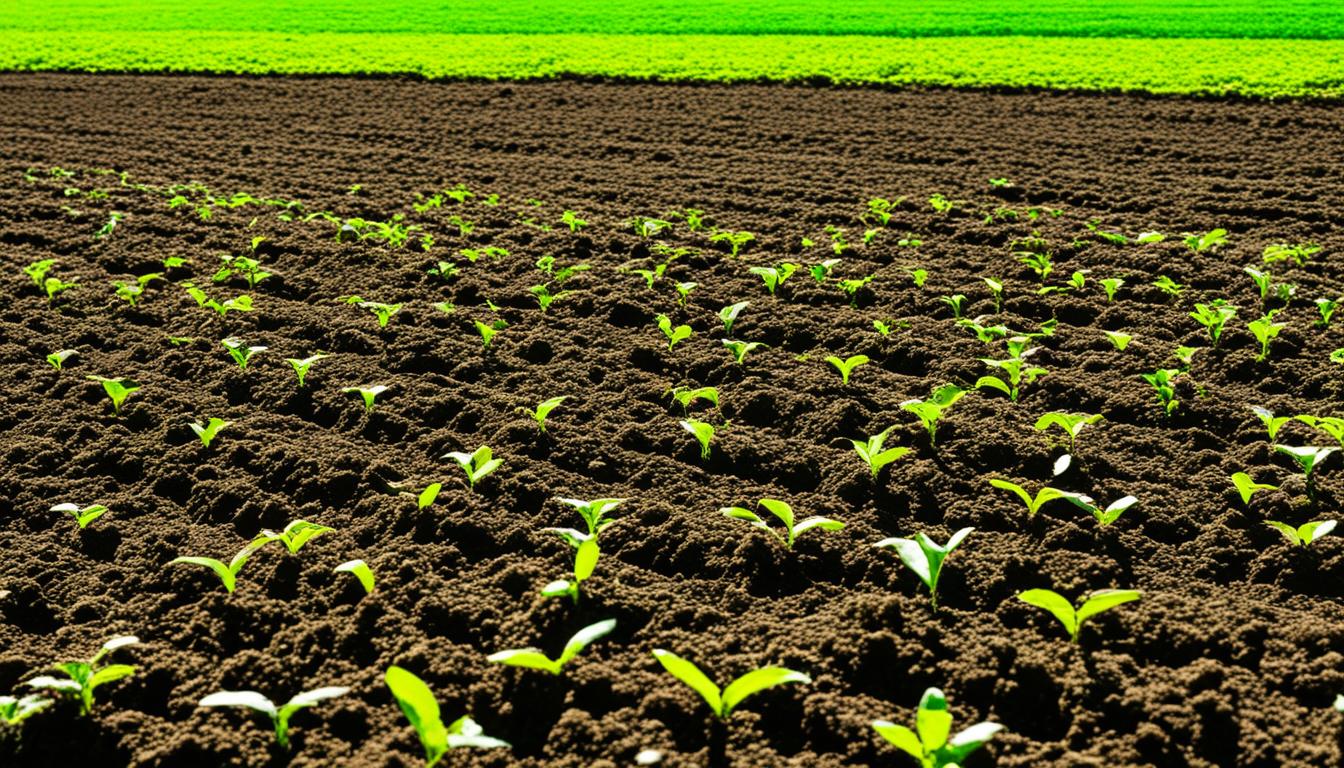
Did you know, U.S. farmlands have lost 60% of their original organic carbon? This comes from soil degradation. It shows we urgently need good ways to keep soil healthy. There are big storms happening more often in the West, Midwest, and Northeast. This is why we must look to the future of our soil and start using ways to take better care of our land.
Soil health is very important for keeping farms productive and the environment clean. Good soil does many things, like soaking up water, recycling nutrients, and locking in carbon. This helps farms deal with the changes in the weather caused by climate change. Groups like FFAR are spending lots of money on projects to help farmers and ranchers look after their soil better.
Looking ahead, it’s key to see how taking care of our soil can do many good things. Better soil can hold more water, keep pests away, and give a home to tiny life in the soil. All this helps keep our land healthy and makes sure farming stays strong.
Good soil is at the heart of farming that is both productive and green. It helps plants grow, keeps us fed, and keeps our air and water clean.
Adding organic stuff and lots of living things helps keep soil rich. This makes sure the nutrients move right, the soil stays strong, and life in the dirt thrives.
Almost all our food depends on healthy soil. So, we must look after the soil with good organic care.
Soil is a treasure that we can’t make more of. We have to care for it well. If we don’t change how we treat the earth, we could lose a lot of soil in just 60 years.
This loss could cost the world $23 million in 2050. More than half of the land we farm is already worn out. This is a big threat to our food.
“Soil contains more than three times the amount of carbon in the Earth’s atmosphere, making its preservation critical in combating climate change.”
Because we can’t make new soil, we must take great care of what we have. We can keep soil healthy by growing plants all the time and keeping the ground covered.
Checking the soil often can help us find and fix problems early. This way, farmers can keep the land in good shape for growing food.
| Aspect | Importance |
|---|---|
| Carbon Storage | Soil holds more carbon than the Earth’s atmosphere, crucial for climate regulation. |
| Food Security | Over 95% of food production depends on healthy soil, linking directly to human health. |
| Economic Impact | Soil degradation potentially costs $23 million globally by 2050, highlighting economic reliance on soil health. |
| Resource Finite Nature | Soil has been declared a nonrenewable resource, necessitating sustainable management strategies. |
Understanding the value of soil life and finding ways to protect it is key. This is crucial not just for saving nature but for keeping food and our economies strong.
By 2050, the world’s population is set to hit 8.9 billion. This will create a massive demand for food. So, we need sustainable ways to farm that keep the soil healthy. These methods also need to improve how much food we can grow.
One key practice is to disturb the soil less. This keeps the soil strong and cuts down on erosion. Research has found that using less aggressive tillage in growing watermelons boosts soil fungi. These fungi are good for soil health.
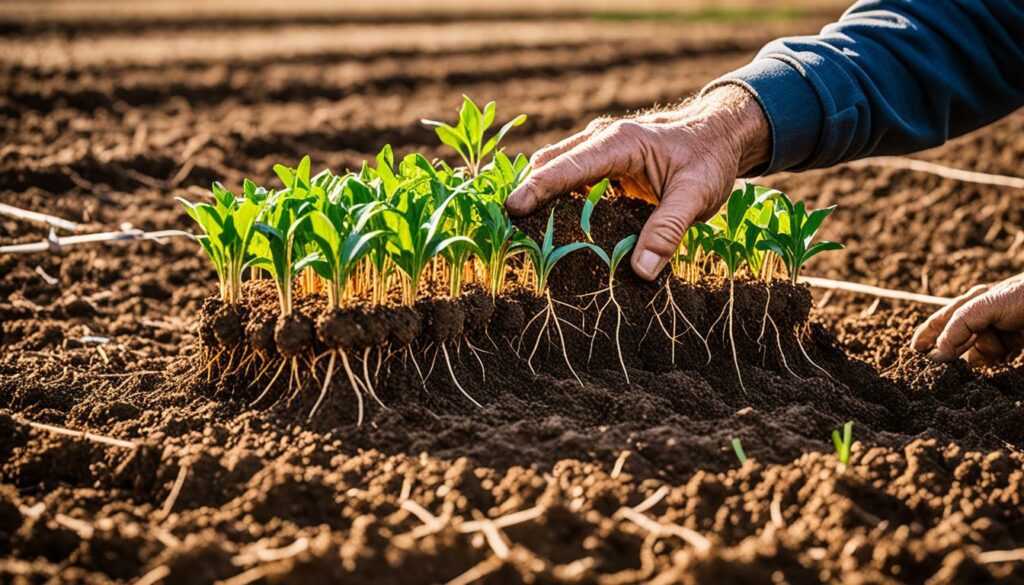
After a seven-year study, researchers found that soil in organic fields had more microbial carbon. This is thanks to methods that don’t disrupt the soil much. So, using these methods helps create soil that’s full of life and nutrients.
Another important step is to cover the soil with plants or organic stuff. This keeps moisture in, stops nutrients from leaving, and protects against erosion. Good soil cover means the land can keep growing food well. It also helps with things like keeping the soil at the right temperature and letting water soak in.
Organic farms with lots of soil cover have more earthworms than conventional ones. This shows the extra benefits of these farming approaches. They don’t just improve the soil. They also encourage more life in the soil. This is good for the future of farming.
Soil biodiversity is critical for our ecosystems to function well. Soil acts as the Earth’s ‘living skin’, home to many organisms. These organisms help with tasks like recycling nutrients, fighting disease, and breaking down harmful substances. We call these the soil ecosystem services.
More and more people are starting to see why soil biodiversity is so important. Back in 2015, experts highlighted soil research across different fields. Then, by 2018, many were working to make sure we look after the soil well. This was to help manage it in a way that keeps it healthy for the long term.
Many areas related to soil health have made big progress. For example, in 2017, a report found that the tiny life in soil could help stop plant diseases. This shows how making soil more diverse can protect our plants.When it comes to conserving soil, a 2015 study explored how to farm in a way that doesn’t harm the soil. It shared ideas for farming that promote biodiversity in the soil. Also, in 2018, another study noted that different farming ways can make the soil healthier. This emphasised how varied approaches are necessary for good soil management.
To show work happening now in soil restoration, think about Guatemala. Their effort in the highlands helped restore over 3,000 hectares of forests. They did it by combining farming with native plants, like alnus trees. This shows a smart way to farm that also protects our environment.
Soil biodiversity makes up a big part of the world’s biodiversity. It’s key for keeping our soil healthy and our ecosystems strong. We must focus on keeping our soil diverse to help the whole environment thrive for a long time.
| Year | Study Focus | Key Findings |
|---|---|---|
| 2015 | Interdisciplinary SOIL | Increased cross-disciplinary research interest in soil science |
| 2018 | Soil Quality Reviews | Ongoing evaluations and improvements in soil health |
| 2019 | Soil Health Assessments | Continued focus on monitoring and enhancing soil quality |
Regenerative farming is more than just farming. It’s a full approach that helps soils grow better and also helps our environment. By using certain methods, we can make our soils healthier and more productive.
Crop rotation is a key regenerative farming technique. It helps in many ways, like improving nutrient use and reducing pests and diseases. When farmers grow different crops in a cycle, they help the soil get back its missing nutrients. This fights off soil erosion, which is a big problem from traditional farming.
Cover crops are also crucial. Farmers plant crops like clover or rye when the main crops aren’t growing. This is to protect the soil and make it richer in nutrients. Cover crops stop soil from washing away and make a home for helpful soil life.
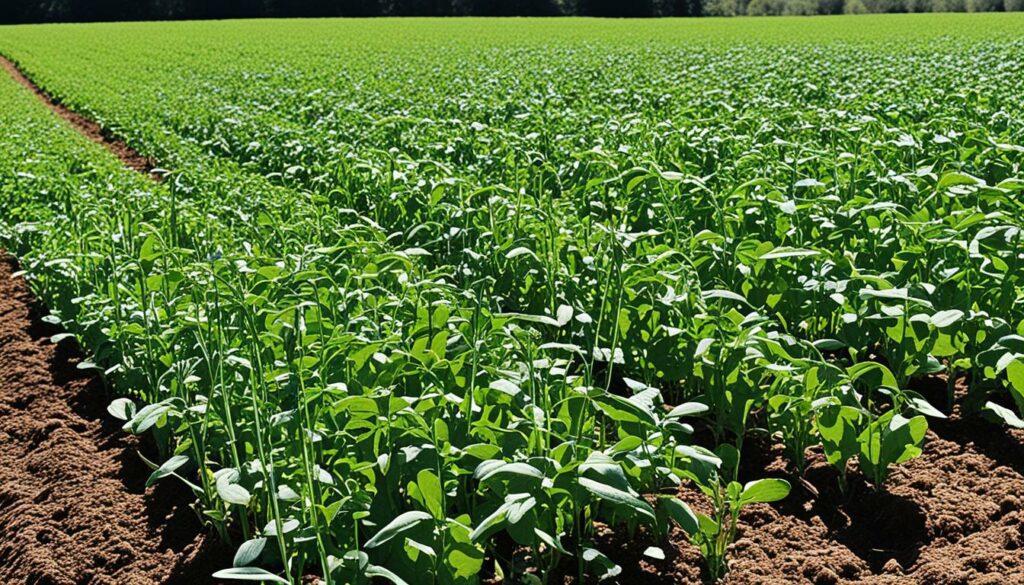
Having animals on the farm is important for regenerative agriculture. The animals eat the grass and help make the soil better. This way, the soil gets more alive and starts working better.
Using green manure is another great move. Farmers grow plants like alfalfa to put nutrients back into the soil. This helps the soil grow food without needing as many chemicals. Plus, it keeps our water cleaner.
| Technique | Advantages |
|---|---|
| Crop Rotation | Improves nutrient cycling, reduces pest and disease pressures. |
| Cover Crops | Reduces soil erosion, enhances nutrient content, improves water retention. |
| Integrating Livestock | Improves soil structure, stimulates biological activity. |
| Green Manure | Enriches soil with nutrients, reduces the need for chemical inputs. |
Using these regenerative farming methods can do a lot for our soil. We’re not only helping the earth. We’re also working towards a fairer farming world. Right now, most land is owned by White farmers. But we’re trying to change that, helping everyone have a chance in farming.
In recent years, advanced tools have changed how we check and look after soil. These tools mix soil tests with new tech like remote sensing. This gives us better info about soil health, helping farmers make smarter choices.
Looking at soil has gotten better over time. Now, we can find out more about soil’s fertility than before. This means we can see what nutrients the soil lacks and add the right stuff to it. A look at 105 to 125 studies showed how key this is. Plus, a big study in 2020 proved that checking soil well is vital all over the world.
Remote sensing tech watches over large areas of soil without touching it. It gathers information fast. Companies such as SoilSerdem and Map My Crop are leading here. They use things like AI and drones to make maps that show soil health. And, new companies like TerraRad and Anton Tech also use drones. They’re looking at the top layer of soil and how much carbon it holds.
All these new methods, along with the old ways, are big steps for soil health checks. They help farming be better for the earth. And they’re key for keeping soil in good shape.
Soil erosion is a big problem for farming that needs solutions. Techniques like contour farming, terracing, windbreaks, and buffer strips help a lot. They keep the soil in good shape for the long term.
Contour farming is ploughing in line with the slope. This stops water from flowing fast, helping to keep soil in place. It makes water stick around longer and fights off soil erosion. Terracing makes big slopes into small steps. This lowers the water’s speed, which cuts soil loss. Both ways make farming more sustainable and productive.
Windbreaks and buffer strips are important too. Windbreaks are rows of trees that slow the wind. This stops the wind from carrying away soil. It also helps wildlife. Buffer strips use plants to filter out bad stuff before it gets to water. They improve the water and make homes for animals.
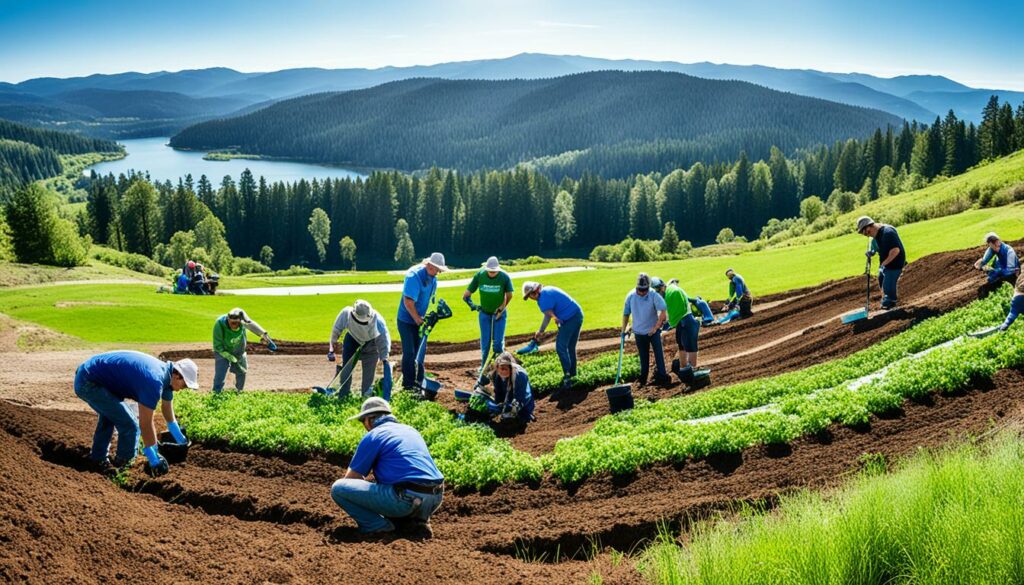
To keep our soil healthy, we must use these methods. They include contour farming, terracing, windbreaks, and buffer strips. They protect our soil and help the whole environment stay in balance.
Climate change is showing its impact on soil health more and more. It changes temperature, moisture, and can increase soil erosion. To fight these effects, we need to change how we manage soil.
In Europe, changing how we deal with soil has helped a lot. It’s made soil less likely to erode, increased its organic carbon content, and made it work better. So, updating soil management is good for the earth and for us.
These actions aren’t just for defence; they help grow more food and store more carbon. A study across 13 European countries shows these benefits clearly. It found that new ways of managing soil can be very helpful.
It’s becoming clear that we need to act fast on soil management. Future projections show big changes in soil quality and erosion. We need to take action now to protect our land.
| Region | Projected Soil Erosion Change | Projected Soil Properties Change |
|---|---|---|
| NSW | 1:50 | 1:42 |
| Europe (13 countries) | Varies | Varies |
Using new ways like increasing soil’s carbon helps us fight climate change on the ground. In Europe, 17 out of 20 studies show these methods work. They help keep our soil better, even with a changing climate.
Managing soil quality is tough and faces many challenges. Problems like contamination, pollution, and too much land use cause issues. These problems harm the soil’s health, structure, and its farming ability.
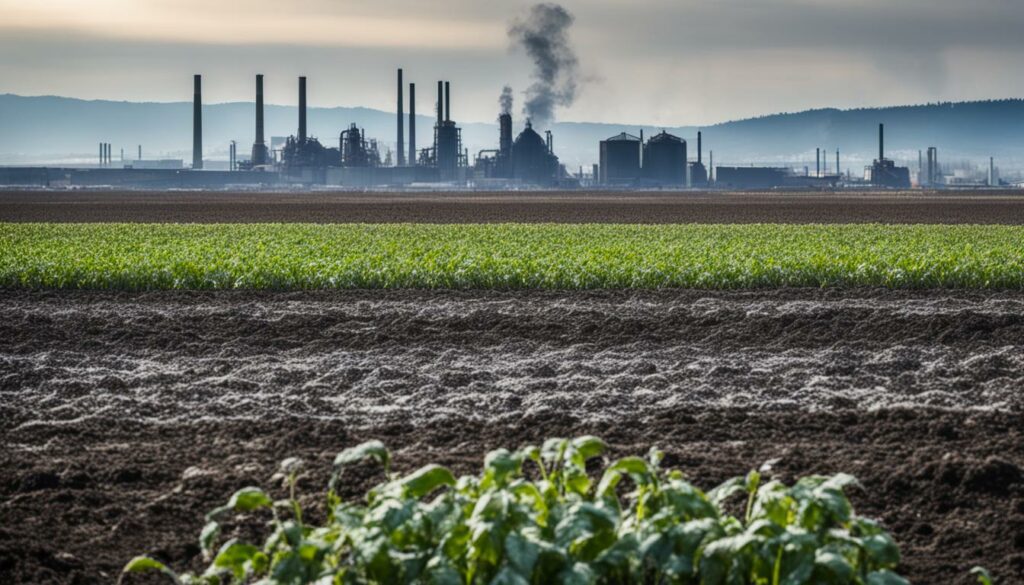
Today, soil faces big challenges from things like pesticides and heavy metals. These chemicals harm soil health. Researchers like Baveye PC have mentioned how complex managing soil is. Studies by Brevik EC and others show how different fields come together to understand soil.
“The interconnectedness between ecosystem services and One Health stresses the importance of soil management practices for various sectors.” – Keith AM, Schmidt O, McMahon BJ. (2016)
Using land too much is a big problem, thanks to heavy agriculture. This causes soil to compact, harming its structure and fertility. Research by Hamza MA states this leads to bad crop growth. But there are ways to fix this.
Reports keep showing that soil quality is falling. This is seen in less organic matter, weaker structure, and shorter roots. The need for understanding soil deeply is shown by Bünemann EK and team’s work from 2018.
Looking at soil quality needs checking these things:
These aspects help check soil quality despite overuse and compaction issues.
| Challenge | Impact | Potential Solutions |
|---|---|---|
| Soil Contamination | Less soil fertility and crops; health risks | Bioremediation; Integrated pest management |
| Soil Compaction | Bad water flow; small root growth | Subsoiling; Controlled traffic farming |
| Land Overuse | Weaker soil; less productivity | Crop rotation; Soil rest periods |
Soil plays a key part in the carbon cycle, storing about 80% of the world’s terrestrial carbon. It is vital for our fight against climate change. The carbon in soil, about 2,500 gigatons (GT), is more than the carbon in the air and plants combined.
Soil is great at storing carbon thanks to its organic matter. This organic material improves soil by holding water and nutrients. This boosts how well plants grow. In total, there is 1,550 GT of organic carbon in the soil. It helps capture more carbon from the air than the soil emits each year.
The interactions in soil are crucial for nutrients and keeping the carbon cycle in check. They make sure that the right amount of carbon gets into the air from plants. Different features like soil type and climate influence how much carbon soil holds. And this affects not just carbon but also other important nutrients cycles, like nitrogen. The right soil care also helps reduce harmful gases like nitrous oxide.
| Carbon Pool | Carbon Content (GT) |
|---|---|
| Soil | 2,500 |
| Atmosphere | 760 |
| Vegetation | 560 |
| Total Terrestrial Ecosystems | 3,170 |
Looking ahead at soil health is key to caring for our land well. It’s all about using new ways to manage soil and knowing more about soil ecosystems.
In 2016, a major study linked soil’s nature services to its value. It stressed how important it is to take good care of the soil. Also, a 2015 study showed that working together in different areas is vital for better soil management. It tells us that good land care needs attention to both nature and money.
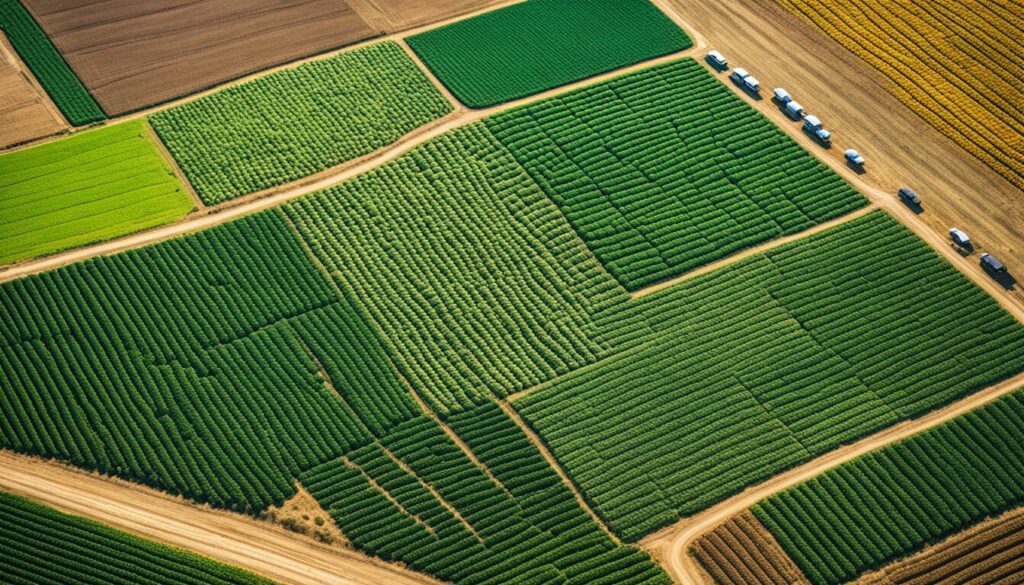
Then, in 2018, a study went deep into what affects soil health. It showed we must keep an eye on and improve soil health. A 2020 study added more, teaching us about the important ways life in the soil interacts. These interactions are key for stronger farming methods.
Did you know, in California, only 5% of farmable land is using the best soil care methods? This shows there’s a lot of space to get better. A detailed report found six big problems stopping these healthy practices from spreading. Solving these problems is a big step towards a better future.
Talking about a 2013 study, knowing and acting to keep soils safe is a must. Healthy soil helps use water better and keeps it, critical for farming success. It’s key to a future where farming can handle changes in water and weather well.
| Year | Study Focus | Key Insight |
|---|---|---|
| 2015 | Interdisciplinary nature of soil | Soil needs teamwork between fields |
| 2016 | Soil ecosystem services and natural capital | Protecting soil is vital for what it gives us |
| 2018 | Soil quality | We must always work to make soil better |
| 2020 | Soil biodiversity and biogeochemical function | Life in the soil and its chemistry are crucial |
| 2013 | Global soil crisis | We need to protect soil to help the planet |
Our goal is to manage land well for the future. This involves using new ideas, growing our knowledge, and tackling the issues with soil health. This way, we build a path to land that’s good for nature and farming.
It’s vital we keep the soil healthy, so our kids have good land to grow food on. This means using farming methods that don’t harm the soil.
Understanding soil is complex and needs careful study according to Baveye PC, Baveye J, Gowdy J (2016). By learning more about soil, we can farm in ways that are better for the earth.
Looking after the soil is key for keeping our planet healthy, as explained by Keith AM, Schmidt O, McMahon BJ (2016). It is vital for keeping nature in balance across the years.
Bünemann EK et al. (2018) found out that taking good care of the soil is essential for the planet’s health. We must farm in ways that help the soil stay fertile and full of life.
Jian J, Du X, Stewart RD (2020) made a tool to check soil health worldwide. This is a big step in knowing how to farm better for the planet.
Trying new farm methods can make the soil better, as seen by Norris CE and Congreves KA (2018). Learning from these methods can help our earth for the future.
No-till farming is good for growing food and keeping the soil healthy, says Ogle SM, Swan A, Paustian K (2012). This is key for sustainable farming practices.
Zimnicki T and others (2020) found that healthy soil makes water cleaner. Healthy soil is vital for saving water and keeping our environment well.
Soil biodiversity is crucial for a healthy earth, says Wagg C and others (2014). Keeping the soil healthy means our world stays in good shape.
Finally, Rillig MC and colleagues (2018) pointed out how important soil life is for food production. Healthy soil is essential for growing our food and making us healthy.
Healthy soil is key for agriculture to be economically successful. Many farms are now using methods to keep soil healthy. This simple change has led to big wins for farmers. They’re seeing more crops, lower costs, and better ways to save water.
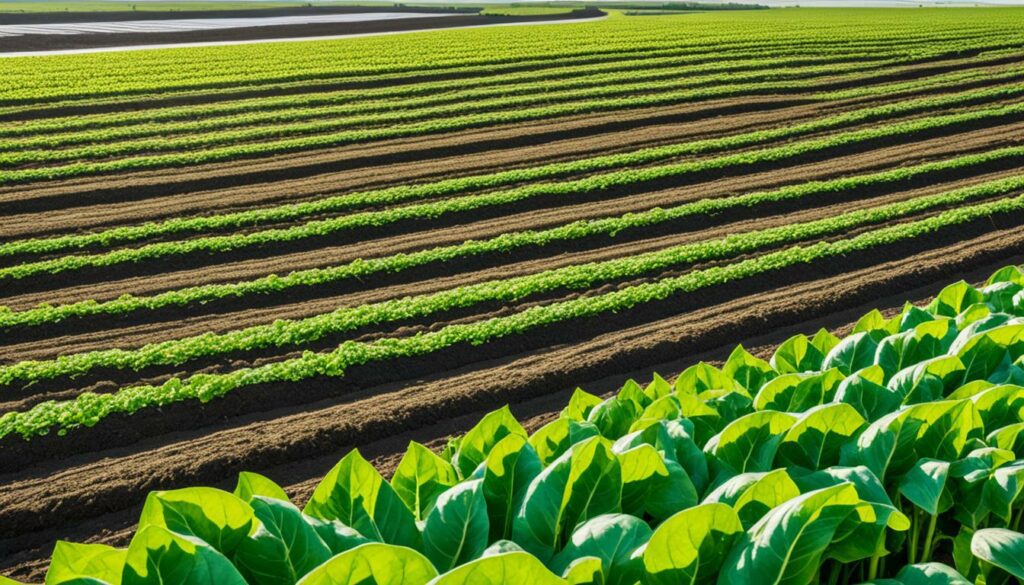
Using methods like no-till and cover cropping has boosted crop production. About 34.6% of farmable lands now use no-till farming. And 8.6% are using cover crops. These methods make the soil better, which helps crops grow more.
With healthier soil, farmers don’t need as much help from things like chemical fertilisers. This reduces the use of chemicals. It also saves them a lot of money. For example, the spending on cover crops by the EQIP program grew from $5 million to over $50 million in eight years. This jump shows how important healthy soil is.
Healthy soil is great at holding and cleaning water. This means less water is needed to grow crops. It also fights the effects of drought. This saves money and protects the environment. For irrigation alone, the US uses about 48.4 million acre-feet of water yearly.
By improving soil health, farmers can use less water. This helps the planet and their wallets. Programs like the CSP, started in 2008, encourage these practices. They promote healthy soil, which is vital for a sustainable future.
The table below illustrates the growing trend towards soil health practices and their economic benefits:
| Practice | Adoption Rate | Economic Benefit |
|---|---|---|
| No-Till | 34.6% of tillable acres | Reduced soil erosion, increased organic matter, lower input costs |
| Cover Crops | 8.6% of cropland farms | Improved soil fertility, enhanced water retention, decreased need for fertilisers |
| Conservation Tillage | 27.5% of tillable acres | Less soil disturbance, better moisture retention, reduced labour costs |
Agricultural technology is leading the way in improving how we manage soil. All around the world, farmers are adopting new tools and methods. These are more efficient and gentler on the planet.
The DUO MAXX fertiliser stabiliser from TIMAC AGRO is one great example. It cuts down on nitrogen loss, which benefits the environment. A soil test in 2022 found that DUO MAXX use meant more nutrients for crops. It also showed there is more life in the soil where it’s used. This means healthier, more fertile soil for farming.
HUMIFLORE and FERTIACTYL also play a big role. They boost soil life and provide important nutrients. This keeps the soil healthy. And healthy soil grows the best crops.
There’s also innovation from startups. CapChar and Photonome are making big moves. CapChar, in the UK, turns wood into biochar. This helps the soil and the planet. In the USA, Photonome uses microbes to make soil better at holding water and nutrients. This makes crops healthier and also helps fight climate change.
Artificial intelligence is changing farming. It makes soil management smarter and more precise. Companies like Verge Agriculture are leading the charge. Their tools help farmers protect the soil by analysing data. This is helping to make farming more sustainable for the future.
The market for soil technology is growing fast. It’s set to reach $57.1 billion by 2028. This shows how important these high-tech solutions are becoming in farming.
| Innovative Soil Products | Key Benefits |
|---|---|
| DUO MAXX | +80% soil CO2, +23% P, +52% N, reduced volatility |
| HUMIFLORE | Increased microbial activity, provides essential nutrients |
| FERTIACTYL | Enhanced soil biodiversity |
Community involvement in soil conservation shows how powerful grassroots movements can be. These efforts help fight the bad effects of soil erosion and pollution. Shockingly, the world has lost a third of its farmable land. This costs the global economy about USD$8 billion every year.
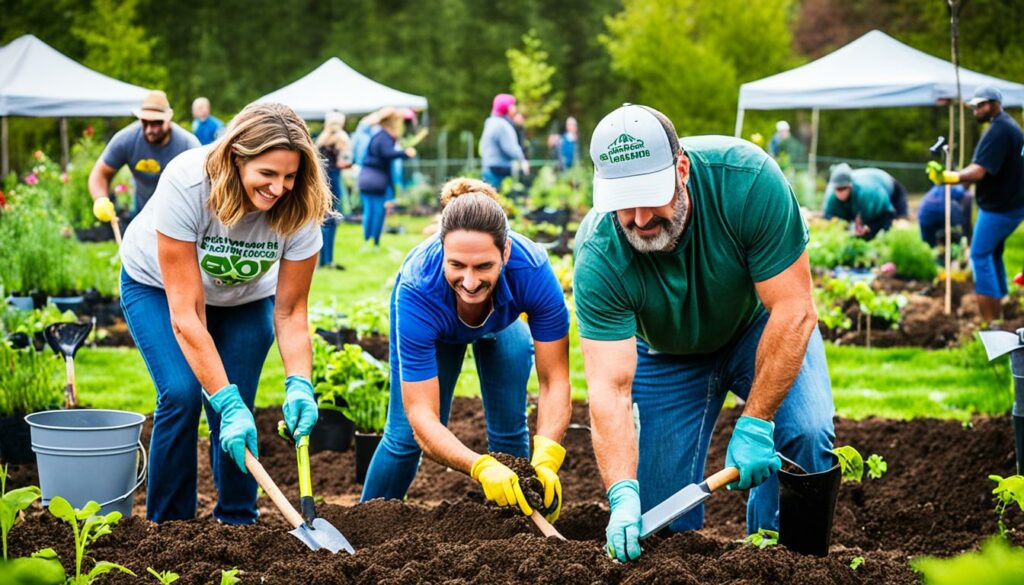
Starting from the ground up, local soil projects are crucial. They stop our land from getting worse. By using eco-friendly methods, we not only protect soil but also boost farm yields. Plus, farming this way means spending less on chemical fertilizers. That’s good news for both the earth and our pockets.
Working together is key to tackle big problems like losing lots of food due to soil erosion. If everyone helps, we can save our land and make it stay healthy. It’s important to stop too many greenhouse gases and keep our soil’s carbon in check. After all, the soil holds most of the earth’s carbon.
In Benin, most of the farming land is in bad shape because of poor farming methods. But through efforts like the Sustainable Land Management Plan (SLM-Plan), change is happening. Not only is the land getting better, but also more young people have jobs in farming. This shows how joining forces for our earth’s sake helps everyone.
| Challenge | Impact | Community Initiative | Result |
|---|---|---|---|
| Land Degradation | Loss of arable land | Sustainable Land Management Plan | Restored soil health |
| Chemical Pollution | Decreased bird populations | Organic farming practices | Enhanced biodiversity |
| Soil Erosion | Reduced food production | Contour farming | Improved crop yields |
| Greenhouse Gas Emissions | Climate change | Carbon sequestration | Stabilised carbon cycle |
The sustainable management of soil is crucial for our farms and environment. Baveye et al. (2016) show it’s important to focus on soil ecosystem services. They say we need to protect soil for the future.
Studies by Stankovics et al. (2018) point out that there are gaps in European laws to protect soil. They argue for better laws to protect our soils. McBratney et al. (2014) talk about the big picture of soil security. They say it’s crucial to look after the quality of soil for our future.
Norris and Congreves (2018) suggest new ways to manage soil in vegetable farming. Carpenter et al. (1998) show how soil health affects water by studying pollution in rivers. These studies underline the key role soil health plays in our environment.
Welch and Graham (2004) examine how breeding crops for more nutrients can boost food security and soil health. Lal (2004) explores how storing carbon in soil fights climate change. Recent studies emphasise that looking after soil needs everyone’s effort, from scientists to local communities and policy makers. By working together, we can protect our lands for the future.
Soil health is key for keeping our farms productive and our environment clean. Healthy soil recycles nutrients, makes soil strong, and helps more plants and animals grow.
Organic materials and many types of living things give soil key nutrients. They also make soil firm and help it work well, keeping it healthy.
Good soil care includes not disturbing it too much, protecting it with cover, and using natural methods. These protect its goodness and its ability to help plants grow.
Techniques like planting different crops each season, adding cover crops, mixing in animals, and using plant-based fertilisers help soil stay rich and support lasting farming.
Having many life forms in the soil helps stop diseases, keeps nutrients moving, and breaks down harmful stuff. This keeps the soil strong and good for growing things.
New tools can check soil without digging it up, using drones and sensors. These help farmers know their soil better so they can take care of it well.
Farming in lines along the land, building steps into steep slopes, and planting wind and leaf fences help stop soil from washing away. This protects farms and nature.
Climate change messes with rain, makes weather more wild, and changes the land’s warmth. This can hurt soil, pushing us to find new ways to keep it healthy.
Keeping soil clean is hard because of bad chemicals and too much use. It makes the soil less good for growing crops, which is a big problem.
Soil is good at storing carbon, which helps fight climate change. It also balances many of the earth’s key cycles, making life on earth possible.
We need to use the land wisely, protect the soil, and learn about the earth’s systems to keep our land rich for many years to come.
Good soil means we can feed many people and keep our planet full of life. It also makes sure our earth can keep giving us what we need, now and in the future.
Rich soil helps crops grow better, saving money on things like chemicals. It also cleans and saves water, making farms more successful.
New tech helps us farm better and keep the soil healthy. Tools like smart machines and analysing data help us do more with less.
Working together on projects to save the land and sharing knowledge makes it easier to keep our soil good for growing food. This is important for all of us.